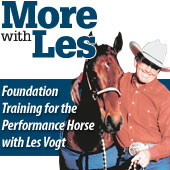 Third in a series
Third in a series
Before entering the arena, we take a closer look at an important piece: snaffle bits.
Now let’s talk about snaffle bits. Snaffles come in an enormous variety of shapes and forms—fat or skinny, smooth or twisted, straight or curved, heavy rings or light rings, D-rings or O-rings, even inlaid and wrapped! And once you’ve decided on a particular bit, you can still change the response you get from it according to how high or low you place it in your horse’s mouth! So where do you start?
Choosing a Bit
On baby colts or fussy mouthed horses I always start with a medium-sized curved bar snaffle. As the horse progresses, you might find you’ll need to move to a straight bar snaffle to keep the horse’s respect and his attention on you.
The critical thing about using a snaffle bit is to make sure your horse respects the bit enough so that he consistently gives you the response you want under pressure. Snaffle bits work through conditioning—our goal is to train the horse until he reacts, almost instinctively, as soon as he feels pressure on his mouth. But if you let your horse lean on the snaffle, or pull against your hand, he will quickly lose respect for the bit and become dull, that is, less responsive in it.
When this happens it’s not over, but it’s going to present a challenge, so your best bet is to take action before it becomes a real problem. So if you feel your horse getting dull or pushy on the smooth snaffle you’ll probably want to quickly upgrade to another bit, which will get his attention back on you. At the same time, you’ll need to look at your own riding and identify areas where you might be letting him lean on your hands too much. We’ll be going into all of this in more
detail in the next section of this program, but we mention it here so you can have the right equipment on hand when you need it.
In terms of upgrading, if you’re starting with a smooth curved snaffle you have a few options. You
can go to a smaller diameter snaffle, a straight smooth snaffle or a twisted snaffle, about the same width as your original bit. My goal is to ride with the upgraded bit for a few days to sharpen the horse’s responses by giving my cues a little more clout, and then go back to the original bit and see if I’ve accomplished anything.
If you’re thinking of showing a young horse in the snaffle bit, you’re going to have to keep him light in a smooth snaffle. If you think you can school at home in a twisted snaffle and then put the smooth one on for the show – you might be in for a wild ride! Believe me, I’ve been there!
Something I do that’s a little different from most is to ride in a bit that’s 6½ inches wide, rather than the standard 6-inch bit. I do this because it gives me more room to create friction by moving the bit back and forth in the horse’s mouth. That way I can get active with my hands, if I need to, without banging him on the cheeks with the bit. If you’re moving a narrower bit back and forth, and your horse happens to open his mouth, the rings can bump against his molars and scuff up the inside of the cheeks, making the horse sore.
I also prefer a snaffle with heavier rings. I think they have more feeling to them and more release when you let go of the reins because the weight of the ring makes sure that the bit falls away from the horse’s mouth very quickly.
More with Les is a regular California Horsetrader column. Les Vogt has won more than 15 World Championships, including two wins at the NRCHA Snaffle Bit Futurity. Although Les still rides and occasionally shows, his focus is giving clinics around the world and developing products for the performance horseman. To learn more about Les and to see his clinic schedule, visit the Web site: www.lesvogt.com. You can also read previous More with Les columns at: http://news.horsetrader.com.
Leave a Comment
All fields must be filled in to leave a message.